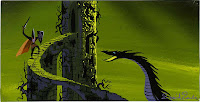You make and animate characters in the following
interrelated and often interwoven stages:
- Scriptwriting, deciding what your character will do.
- Thumbnailing, deciding how your character will look.
- Drawing, deciding how the details of your character will look.
- Modeling, creating geometry for characters, props, and backgrounds.
- Texturing, creating materials for your character and scenes.
- Setup, wrapping geometry around bones and other deformers (sometimes called enveloping).
- Layout, arranging characters in your view.
- Animating, making your characters move. (Layout is often combined with this phase.)
- Lighting, making your animations visible for the camera.
- Rendering, taking moving pictures or "filming" the animation you've created.
- Post-process, sequencing rendered frames with sound, compositing, editing, and output to tape.
As you can see, the procedure is extended, and almost everybody
who creates 3D animation follows it to some extent. Game, motion graphic,
commercial advertising, animation broadcast
video, and feature film studios all use this methodology to varying degrees. But these are
examples of team-based production; individual animation
producers/directors, such as those
trying to produce an animation for use on their demo reels,
are responsible for each phase
themselves. Spending too much time on any one phase or group
of phases can be fatal to the
entire process. As an animator, I tend to focus on getting
to the animation phase as quickly
as possible, while still having an appealing and easy-to-animate
character. My goal in this
chapter is to show you how to speed up these early phases of
the CG (computer graphics)
animation process.
Becoming skilled at computer animation involves negotiating
the dichotomy of learning
the technical processes of the discipline while attempting
to master the art forms of quality
character animation. Complicating this process is the
complexity of character animation
itself, the enormity of Maya (or other high-end 3D packages)
as a piece of software, and the
time constraints inherent in any animation project. Nobody
has an unlimited amount of time
for work (and making peace with that fact is a superb first
lesson), so operating within a
given amount of time is an inevitable constraint. Coming to
grips with the limited resource
of time and comparing it with the enormous volume of work
involved makes you realize
how daunting the challenge of creating quality CG animation
really is—especially in a solo
or small group project!
"It's [baseball] supposed to be hard. I fit wasn't
bard, everyone would do it. The
'hard' is what makes it great."—}immy Dugan (Tom Hanks)
in A League of
Their Own
Computer animation is like baseball, but with the added
difficulty of being perceived
as easy to accomplish. Unfortunately, the rah-rah making of
documentaries, feature-laden
advertisements, and skilled demonstrations by power-using
industry professionals does nothing
to dispel this idea. These facts, coupled with the intrinsic
coolness of creating animated
creatures and worlds, have lead thousands of individuals to
try their hand at animation.
Lured by obsolete tales of Hollywood discovering, hiring,
and training people off the street
and egged on by the desire to see their creations come to
life, people often work diligently to
learn the software but then become puzzled and, in some
cases, discouraged when their skills
are not marketable at their desired employment level. This
is especially true of character animation.
Character animation is hard, and that "hard" truly
does make it great! If it were
easy, everybody would do it well.
Animating well requires that you focus on what you want to
accomplish as precisely as
possible before sitting down at the computer. The first
three phases of the animation process—
scriptwriting, thumbnailing, and drawing—are often called
preproduction. They are
key because you have precious little time to complete an
animation, and the planning, far
from increasing production time, actually shortens it.


Post a Comment